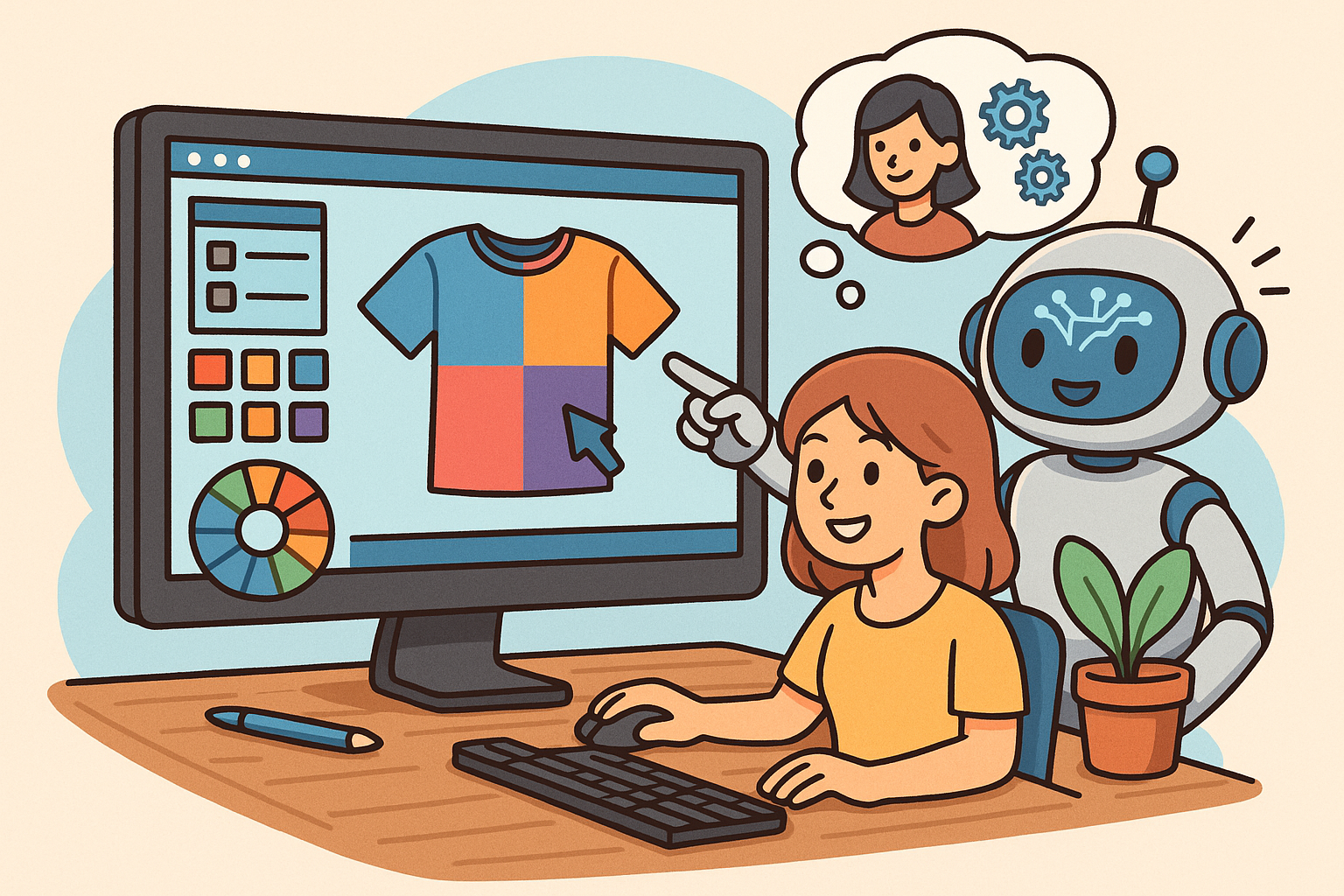Your Cart is Empty
Customer Testimonials
-
"Great customer service. The folks at Novedge were super helpful in navigating a somewhat complicated order including software upgrades and serial numbers in various stages of inactivity. They were friendly and helpful throughout the process.."
Ruben Ruckmark
"Quick & very helpful. We have been using Novedge for years and are very happy with their quick service when we need to make a purchase and excellent support resolving any issues."
Will Woodson
"Scott is the best. He reminds me about subscriptions dates, guides me in the correct direction for updates. He always responds promptly to me. He is literally the reason I continue to work with Novedge and will do so in the future."
Edward Mchugh
"Calvin Lok is “the man”. After my purchase of Sketchup 2021, he called me and provided step-by-step instructions to ease me through difficulties I was having with the setup of my new software."
Mike Borzage
AI-Driven Customization: Revolutionizing User Experience in Design Software
October 05, 2025 9 min read


Introduction
In today’s rapidly changing digital landscape, the role of **customization in design software** has evolved from a static configuration option into a dynamic, user-centric experience driven by artificial intelligence. The integration of adaptive interfaces has not only transformed the way designers interact with their tools but has also shifted the balance of creativity and technology into a more harmonious union, ultimately empowering professionals to tailor every facet of their design environment. This shift arose from the need to reduce manual adjustments while simultaneously offering a personalized workspace that learns from individual user behavior and preferences. Adaptability has become central to how software companies innovate and provide their customers with solutions that feel both intuitive and progressive. Designers now expect interfaces that respond proactively to their workflow, minimizing cognitive load and streamlining complex tasks, and these adaptive systems are increasingly enriched by large-scale user analytics and sophisticated machine learning techniques.
Evolution and Significance of Customization
Throughout the past decade, the evolution of design software has been largely driven by the need for greater user agency and increased efficiency. With the inclusion of **artificial intelligence** components, customization now goes beyond mere aesthetic change—encompassing dynamic adjustment of functionalities, context-aware tools, and smart content suggestions that help designers streamline their process. Numerous successful implementations highlight how data-driven personalization combined with adaptive layouts can dramatically enhance computer-aided design workflows. The emphasis on real-time responsiveness means that design interfaces are now capable of anticipating needs, such as suggesting tool enhancements when switching between detailed schematic design and broad architectural visualizations. This synthesis of data analytics, predictive modeling, and user-centric design opens up new paradigms, where software constantly evolves to meet the unique challenges of each creative task. In a field where precision, efficiency, and personalization are paramount, the move to intelligent, adaptive interfaces represents a significant leap forward for design professionals.
Interface Personalization Driven by AI
The rapid adoption of AI in design environments is not just an upgrade to functionality—it is a step toward a radically different user experience. The design community now benefits from interfaces that automatically adjust toolsets, reconfigure workspaces according to project requirements, and proactively learn from user interactions. This trend is supported by data-centric decision-making processes and innovative algorithms that continuously recalibrate the user interface in real time. Compatible with various design paradigms including additive manufacturing and engineering computation, AI-powered personalization stands at the forefront of digital transformation in creative software. With the rapid integration of adaptive interfaces, it is evident that artificial intelligence is leaving an indelible mark on how designers think, work, and create, enabling them to push the boundaries of what is possible in their specialized fields.
Key Features and Techniques of AI-Powered Customization
AI-powered customization is reshaping the way designers engage with their software by emphasizing **data-driven personalization**, leveraging machine learning algorithms, and ensuring that dynamic layout adjustments optimize the overall design environment in real time. At the core of this transformation is the ability to actively harness user analytics to tailor user interface (UI) elements, making interactions more efficient and intuitive. Machine learning models invest in observing and recording user behavior and preferences to provide a responsive, continually adjusting design environment that meets both immediate and predictive needs. Techniques such as dynamic layout suggestions, automated tool reconfiguration, and context-sensitive help panels represent just a fraction of the innovations enabled by artificial intelligence. This holistic integration allows high-performing design software not only to accelerate the creative process but also to refine design workflows through constant iteration and data aggregation.
Data-Driven Personalization
One of the most compelling features of AI-based customization is its reliance on a thorough analysis of user interactions. Advanced analytics can capture everything from tool usage frequencies to idle times and even the manner in which users interact with specific design elements. These metrics allow the system to constantly refine and adjust the UI. For example, if a designer frequently switches between the material library and 3D modeling tools, the interface will gradually re-prioritize these functions by positioning them more prominently on the dashboard, thus fostering a smoother workflow. The benefits of **data-driven personalization** include a reduction in both time and cognitive load for the user, enabling them to focus more on creative ideation rather than merely navigating the intricacies of the software. This approach fundamentally changes what customization means in a modern design ecosystem.
Machine Learning Algorithms and Dynamic Adjustments
Beyond data analytics, machine learning algorithms are the engine that drives interface adaptation within contemporary design environments. These algorithms are continuously trained on vast datasets comprising real user behavior, feedback, and evolving project requirements. Ultimately, they enable adaptive features that learn from each interaction, making predictive changes that improve usability and performance. Specific examples include the ability to reorder toolbars and menus based on common usage patterns, recommend relevant plugins or assets based on project type, and automatically modify the visual weight or emphasis on particular elements in the workspace. Such dynamic adjustments are essential to providing a holistic, tailored experience for every user. By incorporating models that predict design trends, usage peaks, and potential workflow bottlenecks, the system can act preemptively, ensuring that the interface is not only reactive but also anticipatory in nature, contributing to a seamless balance between automation and hands-on control.
Dynamic Layout Adjustments and Platform Integration
Equally noteworthy is the capacity for dynamic layout adjustments which enable software to reorganize its own structure as user needs evolve. Through predictive models and personalized dashboards, the software continuously recalibrates its layout in response to real-time user data. This means that design software can provide custom views for specialized tasks, ensuring that the relevant tools and resources are immediately accessible without navigating through cluttered menus. Moreover, the integration with existing platforms is a critical proposition; it allows AI modules to enhance rather than disrupt current workflow systems. Developers implement seamless integration strategies using standard APIs and plug-in architectures that do not burden the live environment but instead allow auxiliary modules to work in sync with the core system. Defined by bulleted clarifications, the primary advantages include:
- Enhanced user experience through targeted personalization
- Reduced cognitive overhead by preempting common user actions
- Streamlined workflows across various design disciplines
- Flexibility and scalability in accommodating future updates
Implementation Strategies and Impacts on Design Workflows
The journey toward integrating AI-powered customization into design software involves careful consideration of implementation strategies, selection of the right technical tools, and equilibrium between automation and user control. Achieving successful integration means addressing both the underlying technological framework and the flow of creative work. When incorporating AI modules into design software, best practices include systematic evaluation of existing workflows and transparent testing of new features before widespread deployment. Furthermore, balancing automation with creative freedom is crucial in ensuring that design software remains both powerful and user-friendly. There is an ongoing dialogue between providing users with intelligent recommendations and preserving the organic flow of creative processes, where the user’s direct input is never overshadowed by complex technological interventions. Additionally, the challenges faced during AI implementation are not trivial. Developers must contend with potential data privacy concerns, ensure algorithm transparency, and earn user trust by maintaining control while inviting guided AI participation. Measuring the impacts of these AI-driven strategies on design workflows often reveals improvements in efficiency, creativity, and overall user satisfaction, making it essential for teams to critically analyze and iteratively refine these integrations.
Incorporating AI Modules into Design Software
Introducing AI into existing digital ecosystems requires a robust strategy that prioritizes compatibility, security, and gradual integration. A key aspect of this approach is the evaluation of current design processes and identifying where artificial intelligence can be most effectively inserted without causing operational disruptions. Best practices include building modular plug-ins specifically engineered to interact seamlessly with core functionalities, ensuring that essential design functions remain intact while new AI modules provide added benefits. Developers are encouraged to apply an agile methodology—iteratively testing and refining these modules based on real-time user feedback. The process involves selecting the right toolkits and frameworks that have proven efficacy in predictive modeling, such as convolutional neural networks for image processing or reinforcement learning for interactive workflows. Alongside these technical strategies, implementation success is heavily reliant on transparent communication with end-users, so that designers understand the benefits and limitations of the automated features. Essential steps in this process can be summarized as follows:
- Comprehensive analysis of current design workflows
- Selection and testing of AI algorithms tailored for design tasks
- Modular integration that minimizes disruptions
- Continuous user feedback loops for iterative improvement
- Ensuring data security and algorithmic transparency
Balancing Automation with User Control
One of the critical challenges during the AI integration process is creating a harmonious balance between automated enhancements and manual control over the design process. Even as the software begins to predict and adapt to user needs, designers must retain the autonomy to override suggestions and manually adjust settings where necessary. Maintaining this balance is paramount, as it prevents the risk of over-automation which could potentially stifle creative expression. Effective strategies for balancing this duality include offering customizable levels of AI assistance, where users have the flexibility to dial the degree of automation according to their current project needs. Designers are provided with clear indicators when an AI-driven suggestion is made, and they always have the option to revert to traditional configurations if the preset recommendations do not align with their creative vision. The integration of additional controls, such as undo and modification capabilities, reinforces a trust relationship between the user and the AI system, ensuring that innovative features serve as useful aids rather than constraints. Moreover, empowering users with the transparency to understand why an element has been adjusted by the AI can greatly enhance overall satisfaction and productivity.
Potential Challenges in AI Integration
While the promise of AI-powered customization is substantial, it is crucial to confront the inherent challenges that accompany such technological advances. Among the primary considerations are data privacy concerns, the necessity for algorithmic transparency, and the importance of building user trust. Data privacy issues emerge from the need for continuous data collection to fuel these intelligent systems—a process that must comply with strict regulatory frameworks and ethical standards. Algorithm transparency involves clarifying how decisions are made by the AI, which is essential for maintaining user trust and ensuring that the technology does not inadvertently block creative input. In addition, the balance between providing proactive automation and allowing manual controls often demands nuanced engineering decisions, which can test the limits of current software design methodologies. Addressing these challenges requires a commitment to ethical implementation, robust security practices, and iterative testing that places the end-user at the center of every decision. Key considerations include:
- Ensuring compliance with data protection regulations
- Implementing clear guidelines for algorithm explanations
- Designing fallback controls to maintain user initiative
- Integrating continuous monitoring systems to gauge AI performance
Conclusion
The transformative role of **AI-powered customization** in modern design software has redefined user interfaces by blending advanced analytics, machine learning, and dynamic adaptation into every facet of the creative process. Today’s design environments are better equipped than ever to support designers in realizing their visions by anticipating needs, dynamically adjusting tools, and continuously learning from user behavior. As this technology evolves, designers are witnessing an unprecedented level of personalization, where software transcends traditional roles and becomes a responsive collaborator, effectively augmenting the creative process. The fusion of automation with manual control creates interfaces that are both powerful and intuitive, delivering a level of user satisfaction that is reshaping creative workflows across the board.
Reflections on AI and Personalization
As the boundaries between human creativity and artificial intelligence continue to blur, the integration of adaptive interfaces in design software represents a future that is simultaneously exciting and challenging. The successes of data-driven personalization and the use of sophisticated machine learning models are opening new frontiers in product visualization, engineering computation, and architectural design. These advances provide essential support during the design process while preserving the necessary creative control that drives innovation. By embracing AI, design professionals are redefining the relationship between the tool and its user, turning each interaction into a learning opportunity that benefits the overall ecosystem. Transparency, user empowerment, and consistent performance remain central to the successful integration of these systems. Through careful calibration of AI features and a strong focus on user feedback, the design community is setting the stage for a future where interfaces are as personalized as the visions they help create.
The Future Outlook of Design Software
Looking forward, the role of AI in the continuous evolution of design tools promises to unlock even greater opportunities for innovation. We can anticipate that future design environments will become increasingly proactive, understanding the nuances of each creative workflow and automatically offering the right tools at the right moment. With continued research and development in machine learning, adaptive customization will become not only more accessible but also more finely tuned to the specific needs of diverse design disciplines. The ongoing integration of intelligent modules into established platforms is expected to lead to remarkable efficiencies and creativity enhancements, ultimately redefining the standard of what design software can achieve. As design professionals continue to push the boundaries of what is possible, the potential for AI to act as a true co-creator will undoubtedly drive the next generation of breakthroughs in both creative and technical realms.
Also in Design News

ZBrush Tip: Project All Best Practices: Preserve Sculpt Detail, Polypaint, and Topology
October 28, 2025 2 min read
Read More
AutoCAD Tip: Optimize AutoCAD Layer Management with Layer States and Filters
October 28, 2025 2 min read
Read MoreSubscribe
Sign up to get the latest on sales, new releases and more …



